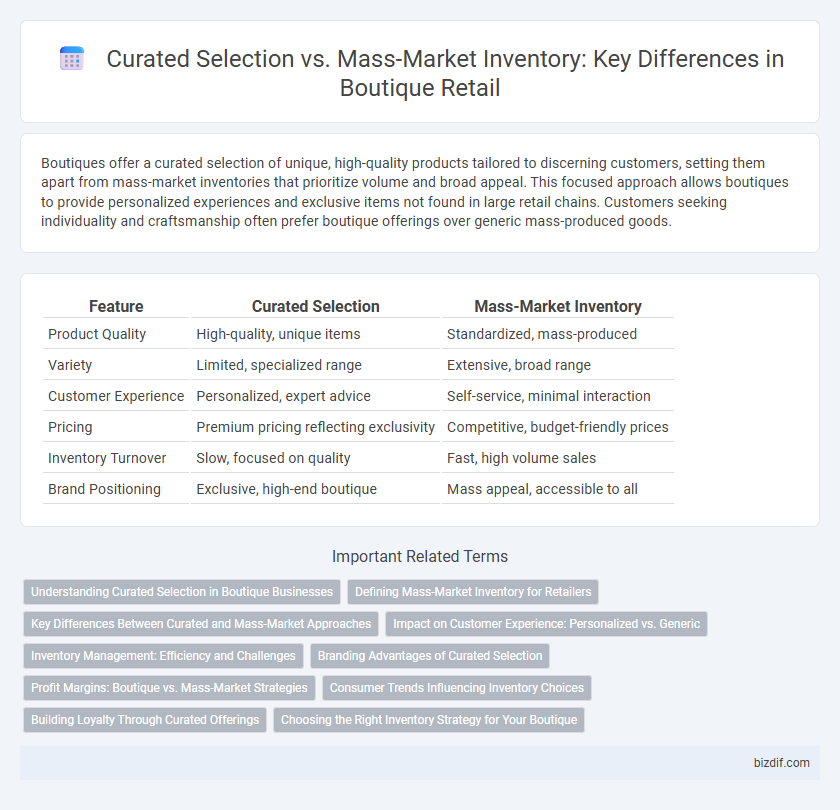Boutiques offer a curated selection of unique, high-quality products tailored to discerning customers, setting them apart from mass-market inventories that prioritize volume and broad appeal. This focused approach allows boutiques to provide personalized experiences and exclusive items not found in large retail chains. Customers seeking individuality and craftsmanship often prefer boutique offerings over generic mass-produced goods.
Table of Comparison
| Feature | Curated Selection | Mass-Market Inventory |
|---|---|---|
| Product Quality | High-quality, unique items | Standardized, mass-produced |
| Variety | Limited, specialized range | Extensive, broad range |
| Customer Experience | Personalized, expert advice | Self-service, minimal interaction |
| Pricing | Premium pricing reflecting exclusivity | Competitive, budget-friendly prices |
| Inventory Turnover | Slow, focused on quality | Fast, high volume sales |
| Brand Positioning | Exclusive, high-end boutique | Mass appeal, accessible to all |
Understanding Curated Selection in Boutique Businesses
Curated selection in boutique businesses emphasizes carefully chosen, high-quality products tailored to niche markets, ensuring exclusivity and unique customer experiences. This approach contrasts sharply with mass-market inventory, which focuses on volume and broad appeal, often sacrificing individuality for quantity. By prioritizing curated offerings, boutiques create strong brand identity and foster customer loyalty through personalized, distinctive merchandise.
Defining Mass-Market Inventory for Retailers
Mass-market inventory for retailers typically includes large volumes of standardized products aimed at broad consumer segments, emphasizing affordability and wide availability. This inventory is characterized by high turnover rates and extensive product variety designed to meet general demand rather than niche preferences. Retailers managing mass-market stock rely on economies of scale to optimize pricing and distribution efficiency.
Key Differences Between Curated and Mass-Market Approaches
Curated selection in boutiques emphasizes carefully chosen, exclusive products tailored to specific customer preferences, enhancing uniqueness and quality. Mass-market inventory prioritizes volume and broad appeal, focusing on wide availability and competitive pricing rather than individualized customer experiences. This key difference impacts brand perception, customer loyalty, and market positioning, with curated boutiques often driving niche appeal and mass-market stores targeting mass consumer demand.
Impact on Customer Experience: Personalized vs. Generic
A curated selection in boutiques offers a personalized shopping experience by providing carefully chosen, unique products that align with the customer's taste, enhancing satisfaction and loyalty. Mass-market inventory, in contrast, delivers a generic assortment designed for broad appeal, often resulting in a less engaging and more transactional shopping experience. The focus on exclusivity and quality in a curated selection creates emotional connections, whereas mass-market inventory prioritizes quantity and accessibility over individualized attention.
Inventory Management: Efficiency and Challenges
Curated selection in boutique inventory management prioritizes quality and uniqueness, enabling precise demand forecasting and reducing overstock risks through focused product assortments. Mass-market inventory involves large stock volumes and diverse SKUs, leading to complex supply chain logistics and higher storage costs. Efficient inventory control in boutiques requires agile systems to balance exclusivity with availability, while mass-market retailers depend on scalable solutions to manage bulk replenishment and minimize stockouts.
Branding Advantages of Curated Selection
Curated selection enhances boutique branding by offering unique, handpicked products that reflect the store's identity and values, creating a distinctive shopping experience. This exclusivity fosters customer loyalty and positions the boutique as a trendsetter, differentiating it from mass-market competitors. Boutique branding benefits from curated collections by emphasizing quality, craftsmanship, and personalized service, which mass-market inventory cannot replicate.
Profit Margins: Boutique vs. Mass-Market Strategies
Boutique stores operating with curated selections typically enjoy higher profit margins due to exclusive, high-quality products that justify premium pricing and foster customer loyalty. Mass-market retailers rely on volume sales and lower prices, resulting in thinner profit margins despite larger overall revenue. Strategic inventory curation enhances perceived value and reduces discounting, directly impacting the profitability of boutique businesses compared to mass-market giants.
Consumer Trends Influencing Inventory Choices
Consumer trends show a growing preference for unique and personalized products, driving boutiques to prioritize a curated selection over mass-market inventory. Shoppers increasingly seek exclusive items and authentic brand stories that stand out from generic offerings. This shift encourages boutiques to focus on limited quantities and niche brands, enhancing perceived value and customer loyalty.
Building Loyalty Through Curated Offerings
Boutiques thrive on curated selections that emphasize quality, exclusivity, and personalization, setting them apart from mass-market inventory flooded with generic products. This tailored approach enhances customer experience by offering unique, thoughtfully chosen items that align with individual tastes, fostering deeper emotional connections and trust. Consistent delivery of distinctive, curated collections cultivates long-term loyalty and transforms customers into brand advocates.
Choosing the Right Inventory Strategy for Your Boutique
Choosing the right inventory strategy for your boutique hinges on prioritizing quality over quantity, with a curated selection offering unique, carefully chosen items that cater to niche customer preferences and enhance brand identity. Mass-market inventory emphasizes volume and broad appeal, often leading to higher turnover but less differentiation in competitive retail environments. Focusing on a curated approach supports customer loyalty and justifies premium pricing by delivering exclusive products not found in mainstream stores.
Curated Selection vs Mass-Market Inventory Infographic

 bizdif.com
bizdif.com